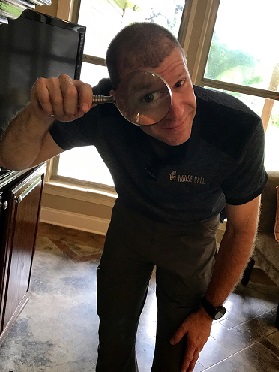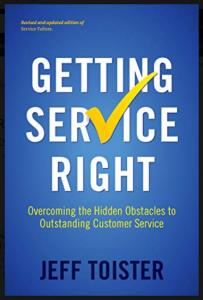Face it, we’re an unknown. The dreaded home inspector. The deal killer. (And yes, one of my agents actually calls me that…) The agents think we’re there to cause trouble; to create hurdles to them closing the deal. But the buyers, they really have no idea what we’re there for. They know that their agent told them they had to call us. They know that they’ve got to pay us. Beyond that, most of them have absolutely no idea what it is we do, why we do it, or who we’re doing it for.
Sounds like the beginnings of a wonderful relationship!

It could be because they got misleading information from their friends or their real estate agent. Or maybe they were watching some knucklehead Canadian on television demolishing a house and then blaming some other home inspector for not detecting a hidden problem. Regardless of where the disconnect lies, our clients really have no idea what’s going to happen on their home inspection.
And that’s certainly a recipe for failure.
Having any gap between our clients’ expectations and the reality of what we do for a living can (and often will) end up causing us problems. If they think we’re going to be doing one thing and we end up doing something totally different from what they’re expecting, disappointment is certain to ensue. And that’s never a good thing.
A disappointed client is a recipe for disaster.
So, what’s a professional home inspector to do?
How do we make sure that our clients are not going to be disappointed?
To quote the venerable Sidney Chaisson, longtime Louisiana licensed home inspector (LA LHI #10001), “Education, education, education.”
If we want our clients to be happy with what we do, if we want them to understand how things will happen, if we want them to realize that we can’t see into the future or predict exactly when their heater will stop working, we’ve got the educate them on the inspection process. It’s up to us to explain to them exactly what we do. We’ve got to provide them with enough information to guide them through not only the inspection process, but the realities of owning a home.
We certainly have to educate them on how the inspection process works. From what’s going to happen while we’re on site to how they’re going to receive their report. From how to read, understand and use their report to how the negotiation process works. From their final walk-through to dealing with the problems that will eventually befall them and their home, educating our clients may be the most important aspect of our job.
When we take time to prepare our clients for the ordeal of the home buying process (as well as the realties of home ownership), we set the stage for a much more enjoyable and productive client/inspector relationship.
There are certainly some inspectors that will disagree, arguing that it’s the real estate agent’s responsibility to educate her client on the home buying process. And I don’t dispute this fact. Any good agent is going to take the time to properly prepare their clients for what’s coming. And I’m not saying that there aren’t some really good agents out there that put their clients’ happiness above their own paycheck, as I work with some of the best agents in my area every day of my life.
My point is that we shouldn’t leave our fate in someone else’s hands. Why would I allow an agent to put their own spin on things when I can explain things myself? I know exactly what it is that I want to relay to my clients. Why should I take a chance on that information being presented in a way that’s not consistent with my message?
Taking the time to educate our clients is always a win-win proposition. When something goes wrong with their home (and something will always go wrong), we want our clients to trust us enough to call us for advice. Taking a few minutes to offer an opinion or provide some guidance beats answering a demand letter from their attorney every day of the week.
Taking a few extra minutes to make sure that we’re all on the same page can go a long way towards building a healthy business relationship between us and our clients. When we make sure that what they’re expecting is in line with what we’re offering, we can avoid a lot of the misunderstanding that leads to disappointment.
A properly prepared client is a happier client.
We should take every opportunity to ensure that our clients’ expectations align with reality. Regardless of what they’ve already been told about what we do, we’ve got to be sure that they understand the realities of a limited, visual inspection. What we do and don’t do when we’re at the house. What we can and can’t do while we’re inspecting. What we will and will not provide them in our report. What we promise and what’s totally out of our control.
Knowledge is power.
attributed to Sir Francis Bacon
We live in an amazing time, with access to an unlimited amount of information and the ability to instantly communicate with almost anyone on the planet. It would be foolish for us to ignore the access that today’s digital age provides us with and let a chance to educate our clients pass us by. We should be utilizing every available opportunity to communicate with our clients, attempting to pass along our knowledge and insight at every turn.
We should take advantage of digital automation to provide our clients with emails and text messages before the inspection happens. We should pass along important items like our inspection agreements, information about any applicable state and local home inspection laws, as well as the inspection standards we abide by.
We should have a professional web presence, where we offer not only the “legal” information that we provide to all our clients, but also present them with an opportunity to learn more about who we are and what we do. By explaining the inspection process and educating our clients on the realities of home ownership, we set them (and us) up for a better experience.
We should encourage them to attend the inspection, so that we’re better able to educate them on our findings and the intricacies of their new home. This opportunity for personal interaction is probably the most important part of the inspection process. It gives us a chance to “interview” them, finding our exactly what it is they’re expecting and adjusting those expectations as needed. It gives them a chance to meet us and see us working. It provides an opening for us to develop the beginnings of a personal relationship, allowing them to view us as another human being instead of simply another faceless entity they had to write a check to during the process of buying a house.

People typically don’t sue people they like, so we should take advantage of every available opportunity to develop a relationship with our clients.
We should explain what it is we’re going to do, how we’re going to do it, and how we’ll let them know about our findings. We should take a few minutes to update them about our progress as we’re moving around the house and we should debrief them at the end of the inspection, discussing our findings and answering any questions that they may have about the home.
We should format our inspection reports in a way that makes them easy to understand and even easier to use. Having a highly technical report may impress the occasional engineer but may end up disappointing the average client who simply wants to know what’s important about their new home.
Overwhelming our clients with too much information and industry jargon is certain to lead to frustration. I get around this problem by including hyperlinks to my website in their inspection report. That way, the clients that want additional information can click a link for more detail, and those that are satisfied with just the basics can easily make it through their report without having to navigate all the extra material.
There’s a fine line between providing enough information for our clients to make an informed decision about purchasing a home and overwhelming them with facts and figures. If our clients struggle to get through their entire report, are we really providing them with value?
A wealth of information (can) create a poverty of attention.
Herbert A. Simon
Using automation to follow up with them after the inspection’s done is an easy and painless way to let our clients know that we care about them and their new home. While properly setting up an automated follow-up series of emails does involve a little work, once it’s completed, we’ve got a powerful tool at our disposal that takes little to no time out of our daily routine to implement.
By simply taking a moment to email them after the inspection, we show our clients that we’re there for them if any questions arise. Doing so reinforces the fact that they mean more to us than simply a paycheck. It also helps to cement in their minds that we’re an authority in our industry and available to them if they ever have questions about their home.
(And it’s a great time to ask them for a nice review on our Google My Business page!)

It can be tough working in an industry where we’re nearly invisible to the general public. The fact that most people haven’t a clue what we do for a living can work against us in many different ways. But if we fail to make a real effort to ensure that our clients know what it is that we’re doing for them, we’re setting them (and us) up for failure.
Take the time to make sure that everyone’s on the same page regarding the inspection process. It’s a common-sense investment that’s sure to pay dividends far into the future.
Would you like to get an email every Friday where we share the newest things we’ve discovered about home inspections? CLICK HERE to sign up.
Want to be an Influencer in Your Field? Share This Post!
Thanks, Joe


